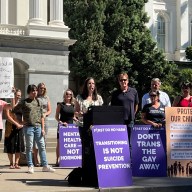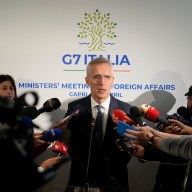TORONTO – Despite the importance of social media in the Ontario election campaign, tweeting will never replace door knocking, and campaigns will still be won and lost offline, politicians and experts say.
They say social media might add a new element to elections, but don’t supersede traditional methods of winning over voters.
Tamara Small, an assistant professor of political science at the University of Guelph, notes that lawn signs and canvassing are still very much in existence in 2011 regardless of social networking.
“Should you have a volunteer go out door to door, or should you have them monitor social media all day?” Small said.
“I might say: ‘Send that volunteer out door to door’.”
Still, all three major parties have campaign teams dedicated to social media.
Rather than battle for undecided votes, the aim is to mobilize their support bases and turn online support into real-world votes
“The only reason we’re doing any of this at the end of the day is not to have the most number of friends, most number of followers, any of that kind of stuff,” said Joseph Lavoie, the director of social media for the Progressive Conservative campaign.
“It’s actually to get out the vote, because none of this is worth it if we don’t win on election day.”
All the parties are on Facebook, Twitter and YouTube, while the Liberals and Progressive Conservatives are using the photo-sharing service Flickr as well.
Both the Tories and Liberals have also developed their own social networking tools.
For example, a Conservative Facebook application lets users earn points toward a prize by taking action to support the campaign, such as signing up for updates, making phone calls or volunteering.
The Liberals have made their own social network called fRed, where supporters can connect and help campaigns.
In contrast, the NDP’s social media specialist, Justin Stayshyn, said the party decided to focus on the “basics.”
“We’re not really doing these flashy apps,” Stayshyn said.
“We feel that our strategy should be like our broader campaign, so keeping it not really about these bells and whistles, but about the basics that people are concerned about.”
Digital public affairs strategist Mark Blevis says social media chatter doesn’t appear to sway many votes.
“(The parties) recognized very quickly that it was a gathering of decided voters,” said Blevis, who closely followed online conversations during the spring federal election.
“People weren’t going there per se to gain points of view and to determine how they were going to vote.”
Nevertheless, Blevis said the creation of apps and networks catering to a party’s base a smart move.
The best campaigns, he said, strike a balance between traditional events such as campaign rallies and connecting with voters online.
“Digital won’t replace traditional (but) traditional cannot exist on its own anymore because the world is becoming more digital,” he said.
“The most successful campaigns are the ones that integrate digital from the beginning.”
Liberal Deb Matthews, a self-confessed Twitter addict, said she loves connecting with people in the “Twitterverse,” but said tweeting is no replacement for meeting constituents face to face.
“The most important thing a candidate can do is get out and knock on doors,” Matthews said.
“Absolutely the best education anybody will ever get is to just knock on doors and ask people what’s important to them.”















